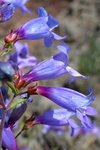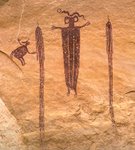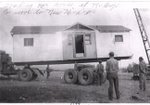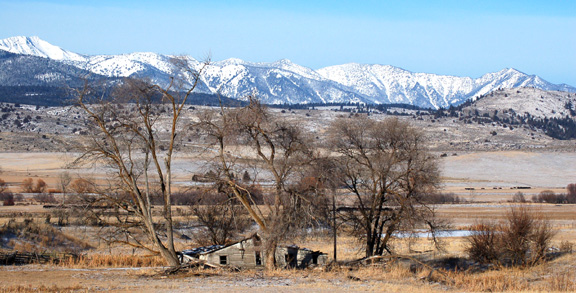Back on December 13th, an anonymous individual posted an off topic ad hominem attack on my Dec. 1st blog which was about the water damage to the County Court house and also the Cole Case. The comment was not about what had been posted on the blog, it was simply a rant against me and another environmental type, because we don't perceive the public lands and grazing abuse the same way the commenter does. I've posted two photos related to this issue below the comments.
Here is the Comment from anonymous:
Anonymous said...
Mr.Christie...Thanks for your comments. I want to inform other people on this site of what a nut case you are. You drive around in your white toyota pickup with barking dog in back, telling local ranchers that you are taking pictures of flowers...come to find out you are trying to find evidence of "overgrazing" and harassing the ranchers and farmers in Baker County that are working hard to provide food for loosers like you. You belong in Portland...not in our wonderful community. Oh, and take Dick Hensey with you. He is nothing more than a nut case extremist also, and needs to go. After all these years have you not figured out that without Agriculture Baker County would be a ghost town? Do something constructive with your worthless lives.
December 13, 2010 5:38 PM
Here is my initial response:
Anonymous:
I don’t normally allow off-topic, hateful, ad hominem attacks on the blog, but made an exception in your case, because I think something instructive, primarily having to do with the activities and attitudes of some ranchers, could come out of it.
Your words remind me of a young rancher I spoke with out at the Hutton Ranch on Goose Creek back in April of this year. On that visit, I had to cross the Hutton Ranch property to access BLM managed public land that the Huttons’ seem, in my opinion, to run like it is their own private cow pasture.
Your words are very similar to those of that same rancher, when he harassed me while I was sitting in my truck on October 8th after I had been out riding my bike and running the dogs on Chandler Lane. The part about “Taking Dick Hensey [sic—actually Hentze, a decent, respected, moderate person- Chris] with you. He is nothing more than a nut case extremist also, and needs to go” is almost exactly what the young rancher told me on October 8th, except that he didn’t call me a nut case extremist to my face.
You left out some things though, like the young rancher asking me in April if I had a rifle so I could shoot any wolves I saw (which would have been a violation of the law), and his telling me in October to never come on his property again, which I would have to do if I were to try to access the same public road on the public’s BLM land.
Making observations about grazing activities is not the only reason I access the public’s land. In fact I was taking photos of plants and critters before I noticed and became interested in what appeared to be, in many arid areas of the west, the wholesale destruction of our public lands and their ecosystems by private, for profit public lands ranchers. The problem is that so much wildflower diversity, and many homes/habitats for wild critters, have been replaced by weed infestations and non-natives due to the rancher’s cows, while the ranchers and the BLM looked the other way. That problem doesn’t leave me much to take photos of—except for grazing damage. So I did. . . .
Now that you have reminded me, I will publish them on a future blog so people can see why the young rancher on the Hutton Ranch told me I could never come on his property again.
Christopher Christie
So in a future post, I'll post some additional photos and some video, and write a little about those condition as well as related issues raised by myself or anonymous, such as ranchers closing off access routes to public land that they graze, with the result that the public can't access their own lands or observe what the public lands rancher is doing to it. . . . . Or whether people who live out on Goose Creek should be considered treasured members of the community, but that people who live in town and think the public lands should be treated with respect, while being forced to pay a weed levy to pay to control weeds caused primarily by ranching and other agricultural activities should leave. . . . . Or whether people who think the public lands should be treated with respect are trying to turn Baker County [sic] into a "ghost town." . . . . Or just what a barking dog in the back of a white Toyota pickup has to do with it. . . . Or. . . . etc.
Below are two early spring scenes on the Goose Creek Allotment.
 Non-Native weeds like Scotch Thistle, #4 on the Baker County "B" designated weed list on the County website, but Class A according to a friend who should know (seen as little gray rosettes in April, Whitetop (# 1 "B" designated weed on the County website, but Class A according to a friend who should know), and Teasel (#9 on the "B" list) have taken over seasonally moist ravines on the Goose Creek Allotment. White top has spread widely, even into dry areas. The Hutton Ranch has had the permit and was running their herd on this public property in Late April. The poorly developed early seral grasses and bare ground leave the hillside soils largely un-protected at this time of year. The white top will continue to spread throughout the allotment, and the scotch thistle will spread, become large and coarse, and crowd out native plants that used to live here. Photo taken on April 25, 2010.
Non-Native weeds like Scotch Thistle, #4 on the Baker County "B" designated weed list on the County website, but Class A according to a friend who should know (seen as little gray rosettes in April, Whitetop (# 1 "B" designated weed on the County website, but Class A according to a friend who should know), and Teasel (#9 on the "B" list) have taken over seasonally moist ravines on the Goose Creek Allotment. White top has spread widely, even into dry areas. The Hutton Ranch has had the permit and was running their herd on this public property in Late April. The poorly developed early seral grasses and bare ground leave the hillside soils largely un-protected at this time of year. The white top will continue to spread throughout the allotment, and the scotch thistle will spread, become large and coarse, and crowd out native plants that used to live here. Photo taken on April 25, 2010. Non-Native weeds like Scotch Thistle, and Whitetop have invaded this hill top on the Goose Creek Allotment. The Whitetop in the photo is just developing the blossomy white top. The scotch thistle is in its small rosette stage but will become large and coarse. Both weeds can crowd out native plants. Photo taken on April 25, 2010.
Non-Native weeds like Scotch Thistle, and Whitetop have invaded this hill top on the Goose Creek Allotment. The Whitetop in the photo is just developing the blossomy white top. The scotch thistle is in its small rosette stage but will become large and coarse. Both weeds can crowd out native plants. Photo taken on April 25, 2010.  The non-native weed Whitetop has invaded even the drier areas of the Goose Creek Allotment. The Whitetop will continue to spread throughout the allotment and crowd out native plants and wildflowers, as it is doing in the area shown by this photo. One friend couldn't see the weeds so I'd like to point out that the lower half of the photo is almost entirely weeds or dead/dying sagebrush. The most developed Whitetop in the photo shows up as a darker green color and some plants, like the ones in the lower right hand corner, are developing blossoms--the white top. There is another weed in the photo as well, perhaps common tansy, but I didn't put it in my notes at the time. Photo taken on April 25, 2010
The non-native weed Whitetop has invaded even the drier areas of the Goose Creek Allotment. The Whitetop will continue to spread throughout the allotment and crowd out native plants and wildflowers, as it is doing in the area shown by this photo. One friend couldn't see the weeds so I'd like to point out that the lower half of the photo is almost entirely weeds or dead/dying sagebrush. The most developed Whitetop in the photo shows up as a darker green color and some plants, like the ones in the lower right hand corner, are developing blossoms--the white top. There is another weed in the photo as well, perhaps common tansy, but I didn't put it in my notes at the time. Photo taken on April 25, 2010 Non-Native weeds like Scotch Thistle, and Whitetop have invaded this draw adjacent to Spring Creek on the Goose Creek Allotment. The Whitetop in the photo is just developing the blossomy white top. The Scotch Thistle plants are most evident as the large gray stems in the foreground. These plants were once large prickly and and course last summer, but have become mere skeletons over winter. Both weeds can crowd out native plants and productive habitat. Photo taken on April 25, 2010.
Non-Native weeds like Scotch Thistle, and Whitetop have invaded this draw adjacent to Spring Creek on the Goose Creek Allotment. The Whitetop in the photo is just developing the blossomy white top. The Scotch Thistle plants are most evident as the large gray stems in the foreground. These plants were once large prickly and and course last summer, but have become mere skeletons over winter. Both weeds can crowd out native plants and productive habitat. Photo taken on April 25, 2010.











